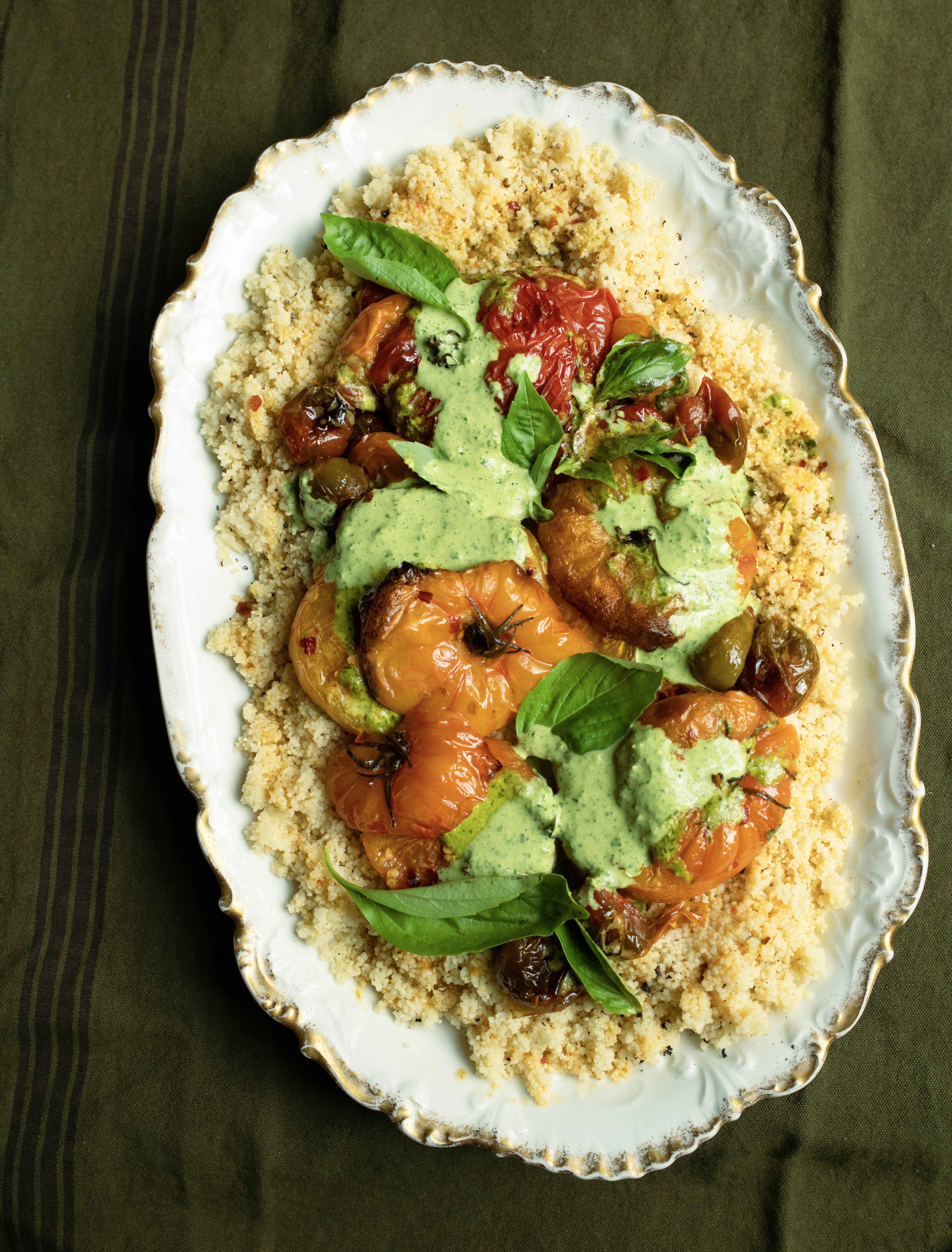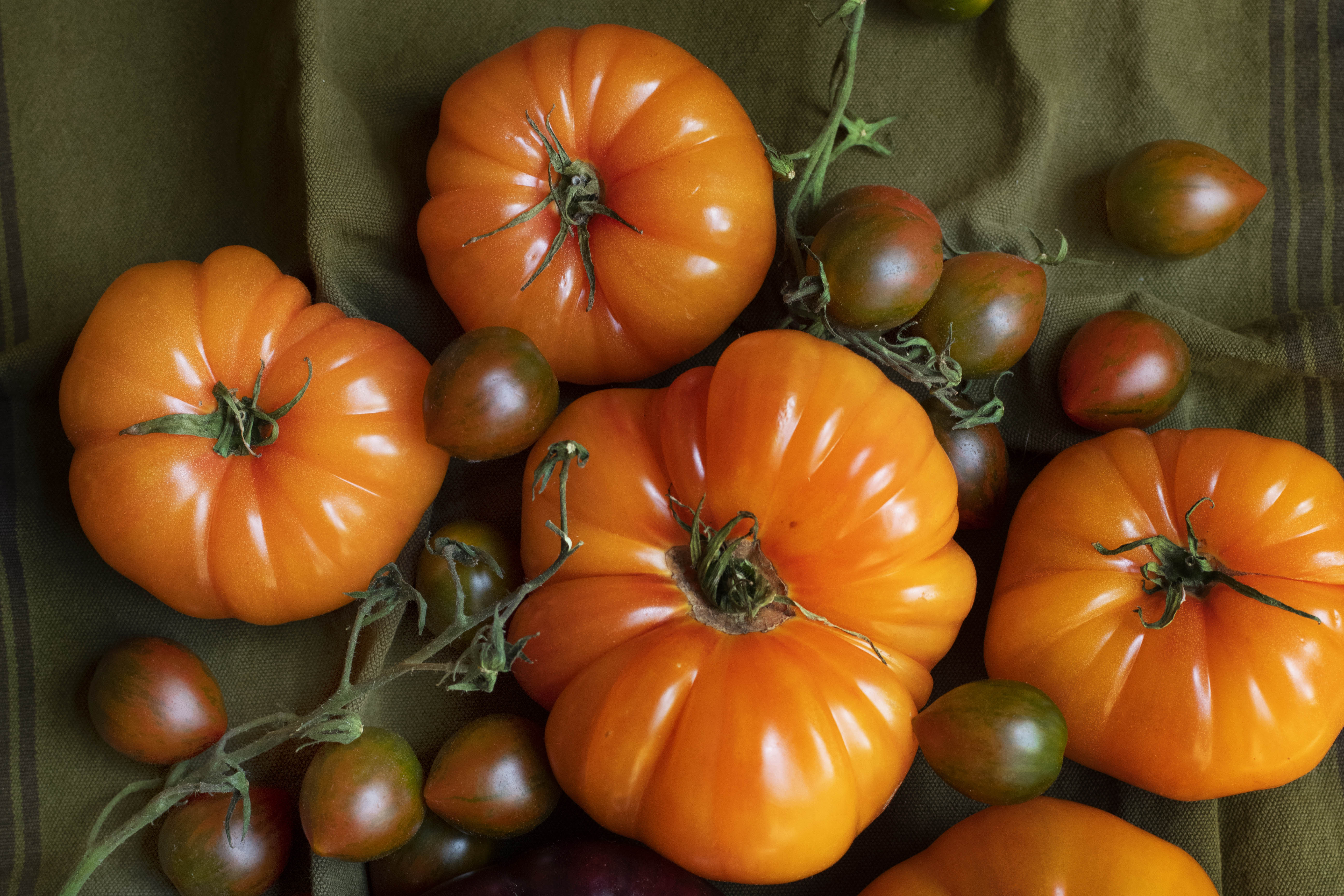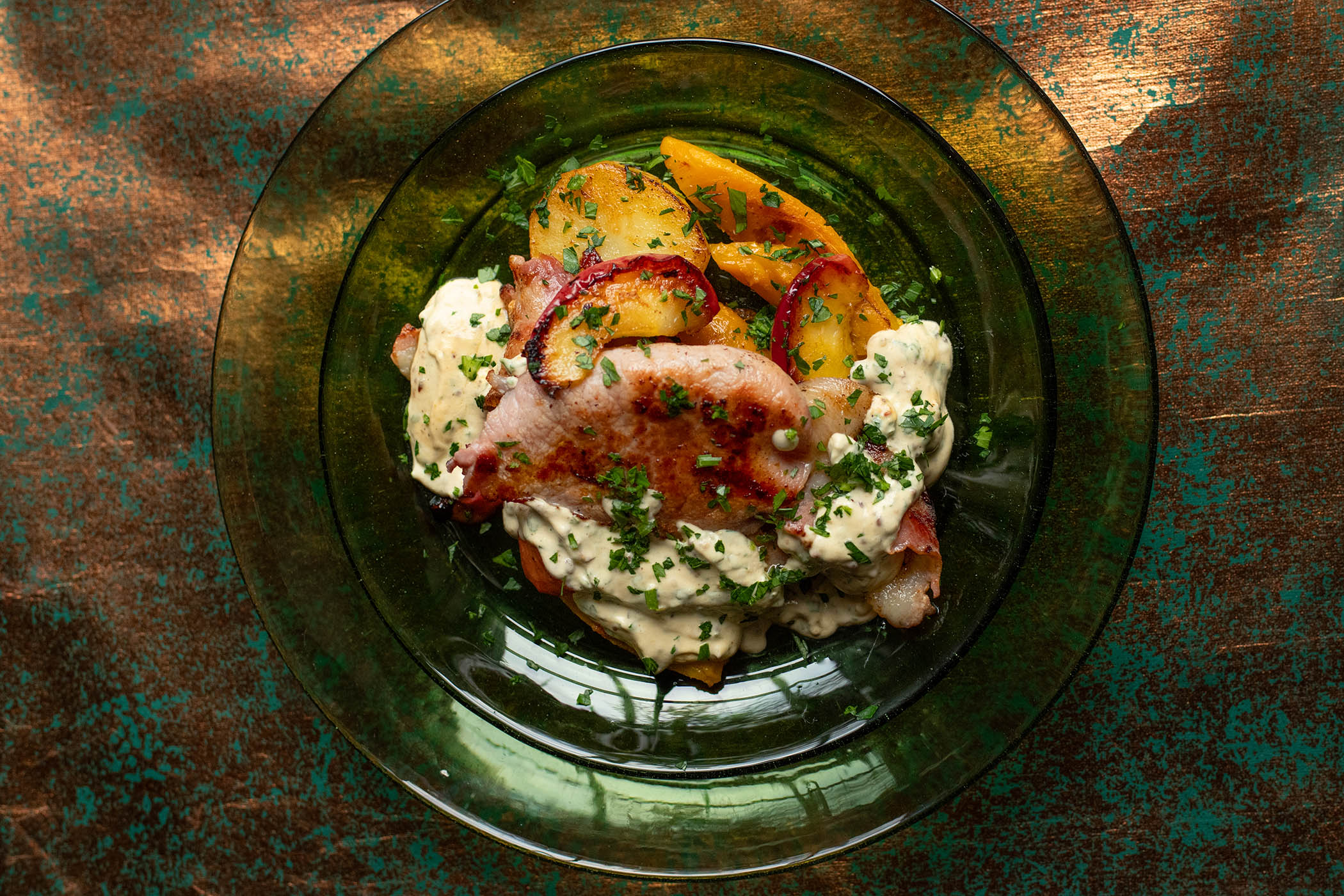Photography by Jonathan Lovekin
Only when I have had my fill of the summer tomatoes, often in the company of basil and burrata (the herbs finely chopped and mixed into the almost liquid, milky cheese with a drop of olive oil) do I start to cook with them. A tray of fruits of mixed sizes and colours – orange, yellow, scarlet, almost black – roasts in about an hour, emerging with the skins scorched and a pool of sweet-sharp juices to spoon over them.
I eat those roasted fruits on toasted bread that I have spread with a paste of green olives, or piled on top of steamed couscous to soak up the juice. Sometimes, I crush them with the potato masher to give a rough-edged sauce for pasta or grilled prawns. You can spoon it over baked courgettes, too, or use it as dressing for grilled aubergine.
The first cooked tomatoes I ever tasted were from a tin, plum-shaped, awash with juice and served on toast at tea time. It would have been considered sacrilege to cook one of the tomatoes from my father’s greenhouse. But a short blast in the oven would have teased out the flavour of even the most insipid tom.
I am not sure anyone needs a sweeter tomato, despite what we are told. What matters is the balance between sugar and acidity and I am hoping for that from the plants in flower on my kitchen roof. They are, naturally, lapping up this summer’s sun and I have high hopes. Or at least some hope. Last year’s crop was something of a washout, like the summer itself. Scorching heat is what we need and, this year, is what we have. If any fruit disappoints by being too bland or too sweet, adding a squeeze of lemon or sherry vinegar should help restore your faith. The tomato’s list of friends is endless, but it particularly likes rubbing shoulders with rosemary, basil, thyme and olive oil, of course, but also vinegar (especially sherry) and perhaps surprisingly, lemon juice. What is less well known is that the sun-ripened fruits have an affinity with both peaches and apricots. This summer’s star salad has been one of sliced white peaches tossed with basil, mozzarella and nasturtium leaves, the last lending a peppery note.
Related articles:
The grill has been quite busy this week. A char-etched dinner of grilled chicken with za’atar and tahini, with courgettes and lemon. A dessert of grilled apricots, the fruits halved, stoned and cooked until they blister and bubble. We ate them with a glistening lemon granita.
Everything in the garden is ripening. I cannot wait for the greengages and the figs. The little apples whose flesh is blushed rose pink. Heaven knows how we will get to the greengages, whose branches tower above the yew hedge and are the very devil to get to. Treasure frustratingly out of reach.
The garden has been warm enough to eat breakfast outside. If it has rained during the night, all the better, so long as I remember to wipe the raindrops from the seats of the garden chairs. An early morning joy has been a marriage of two varieties of melon – watermelon and cantaloupe – with a spritz of elderflower cordial and crushed basil leaves. The strawberries have been so sweet and refreshing this year that I have been adding them to my breakfast bircher muesli. I save a few to slice, but the rest are blended to a coarse purée, then stirred into the oats, yoghurt and grated apple. Served chilled – and it must be – there are few better ways to start a summer’s day.
Roast tomatoes, basil tahini sauce

The small tomatoes burst as they roast and their juices form a sweet-sour dressing for the larger fruits. If the tomatoes have softened but not browned, turn the heat up for the final 10 minutes or so, that way their skins will develop pleasing smoky notes.
Couscous is only a suggestion. You could also serve it with brown rice, which would soak up the tomato juices nicely, or with another small pasta such as orzo, or chewy mograbia. I use a soft, almost pourable tahini. If you have a thicker variety, you might have to tweak the texture with a little more water or lemon juice.
Serves 4. Ready in 1 hour.
For the tomatoes:
tomatoes 750g, assorted
olive oil 80ml
chilli flakes 2 tsp
For the basil sauce:
tahini paste 100ml
garlic 2 cloves
lemon juice about 3 tbsp
basil leaves 10g
parsley leaves 10g
For the couscous:
vegetable stock 500ml
quick-cooking couscous 250g
Heat the oven to 200C/gas mark 6. Slice the larger tomatoes in half across their horizon, then place them cut-side-up in a roasting tin. Tuck any smaller whole tomatoes around them. Mix together the olive oil and chilli flakes, then season with salt and pour over the tomatoes.
Roast the tomatoes for 45-50 minutes until they have softened and the smaller ones have burst, their juices flowing into the tin.
While the tomatoes are roasting, make the sauce. Put the tahini in a blender jug. Peel the garlic cloves and add them to the blender, then pour in the lemon juice and 3-4 tbsp of warm water. Process to a smooth paste, then add the basil and parsley leaves and a generous seasoning of salt (keep in mind that some kinds of tahini are more salty than others, taste as you go). Then continue processing, adding more water if necessary, until you have a pourable, vivid green sauce.
Check the seasoning again, adding more salt or lemon juice as you wish.
For the couscous, bring the stock to the boil in a saucepan. Put the couscous in a heatproof bowl, pour the boiling stock over and leave for 15 minutes to swell. Run a fork through to separate the grains, then pile onto a serving dish.
When the tomatoes are ready, transfer them to the couscous, trickle over the herb sauce and serve, spooning over any juices from the roasting tin.



